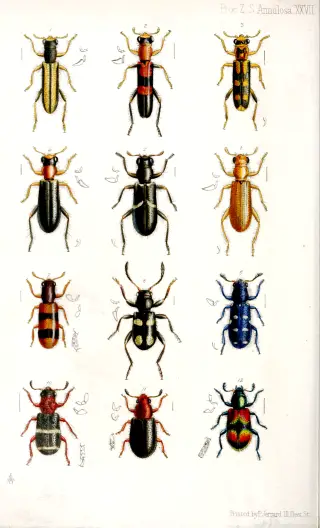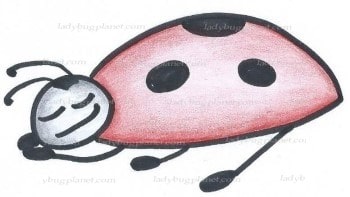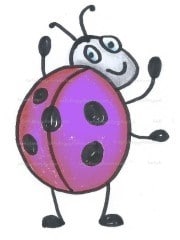We’ve all been there, you find a Ladybug, or so you think, then someone asks … “Is that actually a Ladybug?” You look on the internet and can’t find much out, except maybe a way of identifying the Ladybug … but of course, that’s only if it IS actually a Ladybug.
I’m assuming you arrived here because you want to identify a Ladybug, so let’s see if we can.
During my investigations, I decided to document a handful of the types of insects that could be mistaken for Ladybugs – or indeed some that you’re not sure would be – but are part of the Ladybug family!
So as well as identifying if the bug you found IS a Ladybug, you may be able to investigate what it might be …instead, of a Ladybug. If you get my meaning?
There are many insects that look like ladybugs. Either they’re part of the same family – so technically a Ladybug. Or just similar because they’re in the ‘Beetle family’. Or purposefully posing as Ladybugs for protection purposes. It may need to be identified to know which type.
Either way, if you can’t identify it as a Ladybug, then you can consult this list to search further.
“When is a Ladybug NOT a Ladybug”
Is this a Ladybug I’ve Found
So here I’ve listed a few of the top culprits I’ve found that perhaps are Ladybugs, could be mistaken for Ladybugs – or that might actually be masquerading as a Ladybug on purpose!
Asian Lady Beetle
(Harmonia axyridis)
This might be the most obvious suspect. Although, they are in fact (of course) a species of ladybugs. So technically, if you’re looking at one of these, then you’ve found a Ladybug – well done!
They’re known as the Harlequin Ladybird in the UK. Ladybugs, in general, have a variety of names across Europe!
There are a number of things that set this variety apart from other Ladybugs, which I won’t go into great detail about here as you can see the exact full differences in my Article Ladybug vs Asian Lady beetle. But for quick reference, here are the main factors.
They Are Usually Larger
They may not look it at first glance, but Asian Ladybugs are slightly larger than native Ladybug Species
They Come in More Colors
The Asian Lady beetle has a range of colors, from Red through to Black. They can also have many spots – or no spots at all.
They Have a Larger White Patch
They can be uniquely identified by having a larger white ‘patch’ on their pronotum – which is the protective color over their heads. The shape is white and will look like a letter M when viewing from the rear of the beetle, or M when viewing from the front.
Varieties of Harmonia axyridis…

The above image is courtesy of vulcantermite.com
Clerid Beetle
( Cleridae > Pelonides quadripunctatus)
There are a number of Clerid Beetles which form the Cleridae (Family), also known as Checkered Beetles. In particular, I’m focusing on the coloring of one type which looks a lot like an elongated version of the usual red Ladybug we all know and love.


The Clerid beetle is found worldwide. They’re also very varied in habitats and diet so you could find them virtually anywhere.
They eat pollen, they scavenge or they kill other beetles and larvae. Their larvae – like many beetles are particularly voracious predators.

Clerid Beetle Coloring
Clerid Beetles range in length quite dramatically, from 0.12 in. (3mm) to 0.94 in (24 mm) long. Here are some of the main colors you might find them in. There is quite a range to go on.
image by J.O.Westwood

You might need to know this…
To Work out if a Ladybug is Dead, Dying, or Just Hibernating – click here
Ladybug Mimic Spider
(Paraplectana tsushimensis)
A member of the Orb Weaver Family of spiders. Little is known or written about this mimicking spider. What we do know is that it was documented in 1960, it’s mainly native to Japan, Taiwan, and China, and purposefully mimics a ladybug.
Whether it mimics the Ladybird to ingratiate itself with the Ladybug population on which it (may) prey. Or whether it has adopted the colors in order to offer it protection from predators is not known.

If you’ve come across the Ladybug Mimic Spider then it’s fairly rare, well done! Take a photo and tell your friends!
image by Akio Tanikawa
Scarlet Lily Beetle
(Lilioceris lilii)
If you own Lillies and live in a temperate climate, then you may have encountered this one already.
Scarlet Lily Beetles are a member of the leaf beetle family, of which there are around 37000 (and possibly up to around 50000) separate different species.
To help identify them, they’re bright red – I should probably say scarlet! They’re more elongated than a Ladybug and without spots. Usually around ¼–⅜ in (or 6 to 9 mm) in length, with relatively long legs. Unlike similar cardinal beetles, these have more dimpled elytra.
They winter in the soil, emerging in Spring. Found throughout much of Asia, Europe, and North America, prefer cool and moist climates.
They lay their eggs on the underside of leaves, and around 7-14 days later the eggs produce yellow, orange, or brown larvae. After almost a month of feeding on the plant, they burrow into the soil for the pupation stage – for around 20 days before emerging as adults and continuing their eating.


Did You Know?
Giving a gift of a Ladybug in some form or other for a newborn baby or child is believed to provide them with protection.
Colorado Potato Beetle
(Leptinotarsa decemlineata)
Also known as 28 spotted Lady Beetle, and actually, it is in the same family of beetles as the Ladybug – Coccinellidae. However, the unfortunate thing about this type is they’re not good for the garden!
Mainly as this Ladybug has a single main difference, they do not feed on soft-bodied insects – thus protecting your garden. Instead, they prefer to host on certain plants, like pepper, potato, tomatoes, or eggplant.
Instead of finding above-ground hideaways in winter, adults will spend their time burrowed into the soil, but they’ll still emerge from this habitat when spring arrives.
Their Life Cycle is also a little different from ‘standard’ Ladybugs. But it’s still 4 stages long and about the same length of time and the whole cycle can repeat between 1 and 3 times per annum.
Like their standard Ladybug cousins, they lay their eggs on the underside of live leaves. But when the larva hatches a few days later, they’ll begin to eat the plant or foliage on which they’ve been born.
When it comes time for the third part of the life cycle, they will once again burrow just under the surface of the soil where they will pupate, emerging several days later as adults to complete the fourth stage.

For those keen gardeners out there, should you wish to control these then you will mostly need to do it manually, but collecting up into a jar of soapy water, or you do have the option of using Bacillus thuringiensis var. San Diego.

What Does it mean if you dream about Ladybugs?
Find out here
Golden Tortoise Beetle
(Charidotella sexpunctata)
You think you’ve found the Golden Ladybug! It looks amazing and must surely be the only one in existence. Well, sorry to disappoint you, but you have likely just found the Golden Tortoise Beetle. Similar Shape, but with a changing top coat of gold Elytra that can give off a shiny look to it.
Are Gold Tortoise Ladybugs Poisonous? No, they’re not poisonous to humans in any way. They’re a plant-eating beetle that feeds on plants and foliage such as bindweeds, sweet potatoes, and morning glory. They will feed on this whether in the larva or adult phase.
You can usually find the Gold Tortoise Beetle native to the Americas, in particular South and East North America and most of South America.
Yes, it flies, and yes it eats your plants! And it actually changes color through its development life cycle, or when it’s mating, or in fact when it feels threatened – like when you touch it.
As per the Ladybug family though, the female lays a cluster of eggs on stems and on the undersides of leaves – but usually on a usual host plant. The yellow/brown colored Larva that appears will emerge in approximately 5 to 10 days.

There are many other tortoise beetles that get mistaken for Ladybugs, probably too many to mention here.
Kudzu Bug
(Megacopta cribraria)
Probably from Asia, mainly Japan, Feeds primarily on soybean crops as they suck the nutrients out of the plant reducing the crop yield. They were only relatively recently discovered and have a really offensive smell to them which, like Ladybugs forms part of their 5 defense mechanisms.



They’re part of a larger family of bugs that can vary in shapes and sizes, of which this one resembles a Ladybug. They’re also commonly referred to as stink bugs. But there are a lot of different variants and beetles also given the same name.
Mexican Bean Beetle
(Epilachninae)
This is still part of the Ladybug Family, so again well done, you were right in thinking it was a Ladybug. It’s found mainly in Eastern North America and Mexico (of course!).
However, these are NOT beneficial insects. They may look like an orange ladybug, but they’re bad for your garden and should be removed when you see them.

They feed mainly on Beans, and Legumes such as peanuts, peas and alfalfa – and even clover. But they mostly eat the leaves of the plants, leaving a lace-like appearance to them. Their Larva can inflict more damage than the adults and combined can ruin crop fields. They can also fly long distances to locate new feeding grounds.
Spherical in shape, ranging from bright red to a rustic brown and even golden yellow color. It has 8 black spots so you can hopefully identify it from that. You’ll likely see adults emerging from winter diapause in late spring.

Quick Quiz…
What’s the furthest distance a Ladybug can fly in a single flight?
7.4 Feet, 74 Feet, 7.4 Miles, or 74 Miles
Answer
Spotted Cucumber Beetle
(Diabrotica undecimpunctata)
Ever thought you’d found a green Ladybug? In actual fact, it’s probably not a Green Ladybug at all, but a Spotted Cucumber Beetle. A major pest for agriculture in North America, they eat mainly corn, but also cucumbers, soybeans, beans, and cotton.

Spotted Cucumber Beetle
Their young larva will commonly burrow into the roots of young emerging plants, which destroys the plant.
For identification purposes, Adults are greenish to yellow looking. They have 6 large black spots on each elytron – so 12 spots in total. They’re roughly 0.2 inches (0.5 cm) in length. The larvae are usually yellowish and are long and worm-like in appearance.
Spotted Asparagus Beetle
(Crioceris duodecimpunctata)
Found in most of northern Asia, Europe, and as far across as the UK and Iceland. They’re about ¼ inch (0.64 cm) long, and they’re red to orange looking with 6 black spots on each Elytra – for a total of 12 spots.
Not at all as beneficial as our usual Ladybugs but with a similar life cycle. As the name suggests they feed on asparagus vegetables, The larva is born from green-looking eggs and usually set about eating the berries of the asparagus.


Find out more about the Asparagus Beetle here
Acacia Leaf Beetle
(Dicranosterna picea)
Native to Australia, the Acacia Leaf Beetle looks a lot like the archetypal Ladybug – except it feeds on the Acacia Plant. Reddish brown in color, about 0.47 inches (or 12 mm) in length, round, and with a dimpled appearance on their back. No spots though.
They devour Acacia plants all year round. The larva hatch in summer, they are dark reddish brown in appearance once fully formed.


Images and info courtesy of brisbane insects, who tracked the hatching and growth of some acacia beetles.

In Other News…
Check out this incredible Purple Ladybug
You wouldn’t believe it exists!
Flea Beetle
(subfamily – Galerucinae)
A metallic-looking beetle, belonging to the leaf beetle family. They’re of comparable shape and size to Ladybugs but more elongated.
They can walk, they can fly, but they can also jump – which is facilitated by strong and thick hind legs. They can come in a variety of colors, usually darker in nature and metallic looking.
Flea Beetles mainly feed on the surface of the leaves, stems, and petals. Considered pests OR beneficial insects depending on the exact variety.
Some eat mustard and rapeseed as well as a number of garden plants. Some feed mainly on weeds and have been introduced in some areas as beneficial insects.
On wet days they burrow into the soil to seek shelter, so they’re most active on warm dry days.
As with most of these, there are lots of types of flea beetles. Below are common ones, but you can find all the types here.


We All Misidentify Ladybugs
We’re all prone to making errors in identification. And it’s easy to understand why.
So these are just a few, and there are probably thousands more, perhaps less common ones.
To paraphrase Wikipedia on this subject…
“As well as the usual colorings, many Ladybug species are mostly black, dark grey, gray, or brown, and may be difficult for non-entomologists to recognise as Ladybugs at all. Non-entomologists are also prone to misidentify a wide variety of beetle species from other families as “ladybugs”,
wikipedia
Did We Find It?
If you managed to identify it for you then please leave a message in the comments below. I’d love to think I helped someone!
This handful I’ve added is probably just scratching the surface! There are hundreds of thousands, if not millions of different kinds of beetles out there, so it’s always going to be hard to tell.
I’ve listed some more obvious options, but if you find one then do let me know in the comments below, I’ll investigate it and add it to the list if it feels like it should belong.
Of course, not there’s always the chance you’ll be investigating every Ladybug you find! That’s no bad thing!
If you liked this post then of course feel free to comment below and share it. I’ve also spent lots of time researching the best Ladybug Gifts, Charms, and Educational Activities out there for all you lovely Ladybug Lovers! I’ve put lots of other things into my Resource Pages so be sure to check them out!
Related Questions
Where Can Ladybugs Be Found? Ladybugs inhabit all parts of the world that have a temperate to warm climate.
This rules out the northern part of North America and Asia, along with the Arctic and Antarctic where the weather is too cold most or all year. Find them in gardens, fields, crops and anywhere plant pests are likely to feed.



Thank you for the information, I have caught 2 Mexican bean beetles. They look like ladybugs, but they are orange, and their “heads’ are orange. Really appreciate your article with pictures.
You’re very welcome Tanya, really glad it helped 🙂 x
I just saw what I thought was a ladybug but its body was long and narrow, with a light red thorax and gradually lighter wings, ending in a very pale peach color. The bug had very long, distinguished antennae which appeared to be horizontal black and white (or black and light yellow) bands, i.e., I would guess there were about 30 alternating bands per antenna. So far I have been unable to find a photo resembling this bug which I presume is some kind of beetle. I should carry a camera when I take a walk!
Thanks,
Anna
Hi Anna,
Thanks for the comment, that’s interesting. It could be a ten striped June Beetle, a striped blister beetle, or cucumber beetle. So perhaps check those two. If you can Send Me a photo then maybe I can help further.
The other day I had a big land on my arm that was so unique, it was the same size as a lady bug but, it’s outer body edge was a rose pink and it has a silver iridescent center while landed! I’ve never seen such a beautifully colored bug!
Can anyone tell me what this beauty may have been? I’ve never known of a ladybugs being those colors! Thanks
Thank you for your post. It helped me identify the almost look-alike lady bug in my garden. I had never seen it before. It must be new to my area.
You’re very welcome Pat, happy to help 🙂
I’ve found a bug on my apple tree, looks very much like a ladybug, coloured orange with black spots, but doesn’t seem to have legs. Instead has a number of small white pincers which are clinging on to the leaf at one end, and a body curled up slightly like a caterpillar. It might be a caterpillar, but it doesn’t move around like one, just stays clinging to the one spot.
Any ideas?
Thanks, Josh, sounds like this could be a Ladybug Larva
Thank you for the article and pictures. I was able to identify an asparagus beetle.